The Role of HR Planning in Responding to Challenges and Opportunities
VerifiedAdded on 2022/08/28
|7
|2897
|22
Essay
AI Summary
This essay delves into the crucial role of Human Resource (HR) planning in New Zealand organizations, specifically addressing the challenges and opportunities presented by technological advancements, workforce diversity, and evolving employment patterns. The essay emphasizes the importance of HR planning as a strategic approach to optimize the utilization of employees, ensuring the best fit between individuals and their roles to mitigate manpower shortages. It examines how technological changes, including the need for digital transformation strategies and the integration of artificial intelligence, impact HR planning. Furthermore, the essay explores the challenges associated with workforce diversity, such as bias, flexibility issues, and wellbeing concerns, and suggests strategies for mitigation. The analysis of employment patterns, including flexible workforces and part-time employment, highlights the need for HR to adapt recruitment processes, job design, and analysis. The essay underscores the significance of HR planning in addressing these issues and creating effective communication, establishing rules, and maintaining fair practices to enhance organizational productivity. The essay concludes by emphasizing the comprehensive responsibilities of HR planning in managing these multifaceted challenges and opportunities to foster a thriving organizational environment.
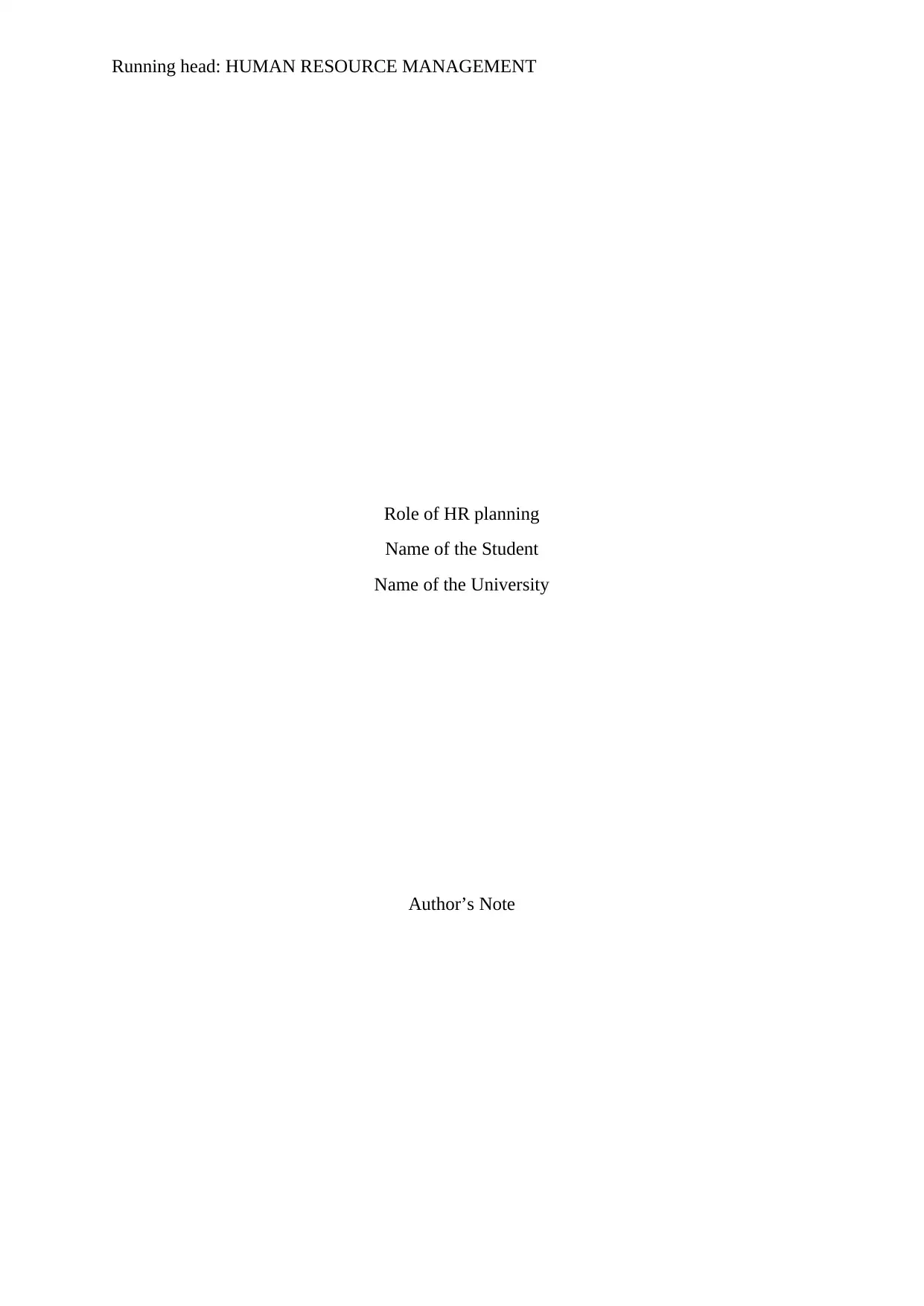
Running head: HUMAN RESOURCE MANAGEMENT
Role of HR planning
Name of the Student
Name of the University
Author’s Note
Role of HR planning
Name of the Student
Name of the University
Author’s Note
Paraphrase This Document
Need a fresh take? Get an instant paraphrase of this document with our AI Paraphraser
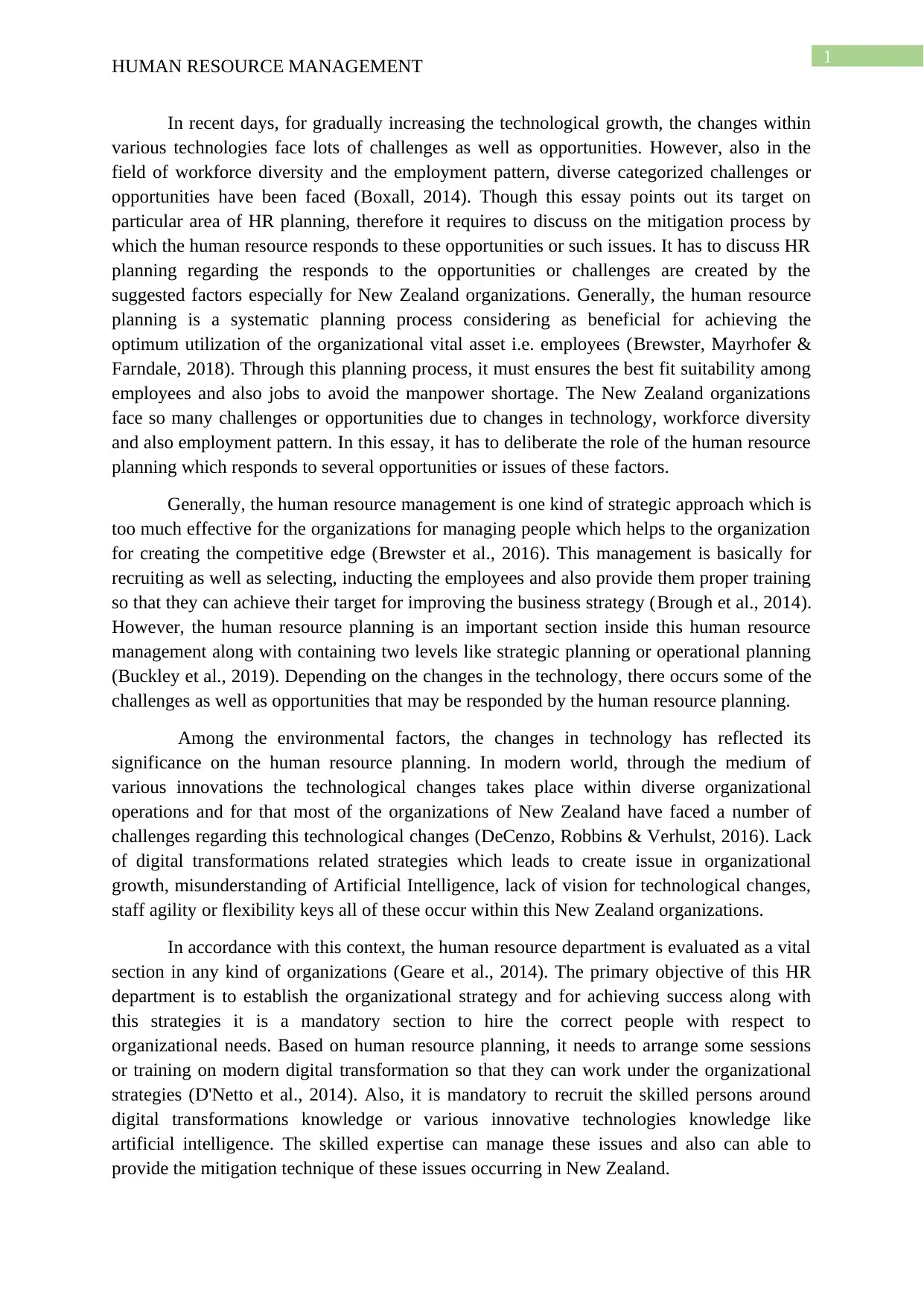
1
HUMAN RESOURCE MANAGEMENT
In recent days, for gradually increasing the technological growth, the changes within
various technologies face lots of challenges as well as opportunities. However, also in the
field of workforce diversity and the employment pattern, diverse categorized challenges or
opportunities have been faced (Boxall, 2014). Though this essay points out its target on
particular area of HR planning, therefore it requires to discuss on the mitigation process by
which the human resource responds to these opportunities or such issues. It has to discuss HR
planning regarding the responds to the opportunities or challenges are created by the
suggested factors especially for New Zealand organizations. Generally, the human resource
planning is a systematic planning process considering as beneficial for achieving the
optimum utilization of the organizational vital asset i.e. employees (Brewster, Mayrhofer &
Farndale, 2018). Through this planning process, it must ensures the best fit suitability among
employees and also jobs to avoid the manpower shortage. The New Zealand organizations
face so many challenges or opportunities due to changes in technology, workforce diversity
and also employment pattern. In this essay, it has to deliberate the role of the human resource
planning which responds to several opportunities or issues of these factors.
Generally, the human resource management is one kind of strategic approach which is
too much effective for the organizations for managing people which helps to the organization
for creating the competitive edge (Brewster et al., 2016). This management is basically for
recruiting as well as selecting, inducting the employees and also provide them proper training
so that they can achieve their target for improving the business strategy (Brough et al., 2014).
However, the human resource planning is an important section inside this human resource
management along with containing two levels like strategic planning or operational planning
(Buckley et al., 2019). Depending on the changes in the technology, there occurs some of the
challenges as well as opportunities that may be responded by the human resource planning.
Among the environmental factors, the changes in technology has reflected its
significance on the human resource planning. In modern world, through the medium of
various innovations the technological changes takes place within diverse organizational
operations and for that most of the organizations of New Zealand have faced a number of
challenges regarding this technological changes (DeCenzo, Robbins & Verhulst, 2016). Lack
of digital transformations related strategies which leads to create issue in organizational
growth, misunderstanding of Artificial Intelligence, lack of vision for technological changes,
staff agility or flexibility keys all of these occur within this New Zealand organizations.
In accordance with this context, the human resource department is evaluated as a vital
section in any kind of organizations (Geare et al., 2014). The primary objective of this HR
department is to establish the organizational strategy and for achieving success along with
this strategies it is a mandatory section to hire the correct people with respect to
organizational needs. Based on human resource planning, it needs to arrange some sessions
or training on modern digital transformation so that they can work under the organizational
strategies (D'Netto et al., 2014). Also, it is mandatory to recruit the skilled persons around
digital transformations knowledge or various innovative technologies knowledge like
artificial intelligence. The skilled expertise can manage these issues and also can able to
provide the mitigation technique of these issues occurring in New Zealand.
HUMAN RESOURCE MANAGEMENT
In recent days, for gradually increasing the technological growth, the changes within
various technologies face lots of challenges as well as opportunities. However, also in the
field of workforce diversity and the employment pattern, diverse categorized challenges or
opportunities have been faced (Boxall, 2014). Though this essay points out its target on
particular area of HR planning, therefore it requires to discuss on the mitigation process by
which the human resource responds to these opportunities or such issues. It has to discuss HR
planning regarding the responds to the opportunities or challenges are created by the
suggested factors especially for New Zealand organizations. Generally, the human resource
planning is a systematic planning process considering as beneficial for achieving the
optimum utilization of the organizational vital asset i.e. employees (Brewster, Mayrhofer &
Farndale, 2018). Through this planning process, it must ensures the best fit suitability among
employees and also jobs to avoid the manpower shortage. The New Zealand organizations
face so many challenges or opportunities due to changes in technology, workforce diversity
and also employment pattern. In this essay, it has to deliberate the role of the human resource
planning which responds to several opportunities or issues of these factors.
Generally, the human resource management is one kind of strategic approach which is
too much effective for the organizations for managing people which helps to the organization
for creating the competitive edge (Brewster et al., 2016). This management is basically for
recruiting as well as selecting, inducting the employees and also provide them proper training
so that they can achieve their target for improving the business strategy (Brough et al., 2014).
However, the human resource planning is an important section inside this human resource
management along with containing two levels like strategic planning or operational planning
(Buckley et al., 2019). Depending on the changes in the technology, there occurs some of the
challenges as well as opportunities that may be responded by the human resource planning.
Among the environmental factors, the changes in technology has reflected its
significance on the human resource planning. In modern world, through the medium of
various innovations the technological changes takes place within diverse organizational
operations and for that most of the organizations of New Zealand have faced a number of
challenges regarding this technological changes (DeCenzo, Robbins & Verhulst, 2016). Lack
of digital transformations related strategies which leads to create issue in organizational
growth, misunderstanding of Artificial Intelligence, lack of vision for technological changes,
staff agility or flexibility keys all of these occur within this New Zealand organizations.
In accordance with this context, the human resource department is evaluated as a vital
section in any kind of organizations (Geare et al., 2014). The primary objective of this HR
department is to establish the organizational strategy and for achieving success along with
this strategies it is a mandatory section to hire the correct people with respect to
organizational needs. Based on human resource planning, it needs to arrange some sessions
or training on modern digital transformation so that they can work under the organizational
strategies (D'Netto et al., 2014). Also, it is mandatory to recruit the skilled persons around
digital transformations knowledge or various innovative technologies knowledge like
artificial intelligence. The skilled expertise can manage these issues and also can able to
provide the mitigation technique of these issues occurring in New Zealand.
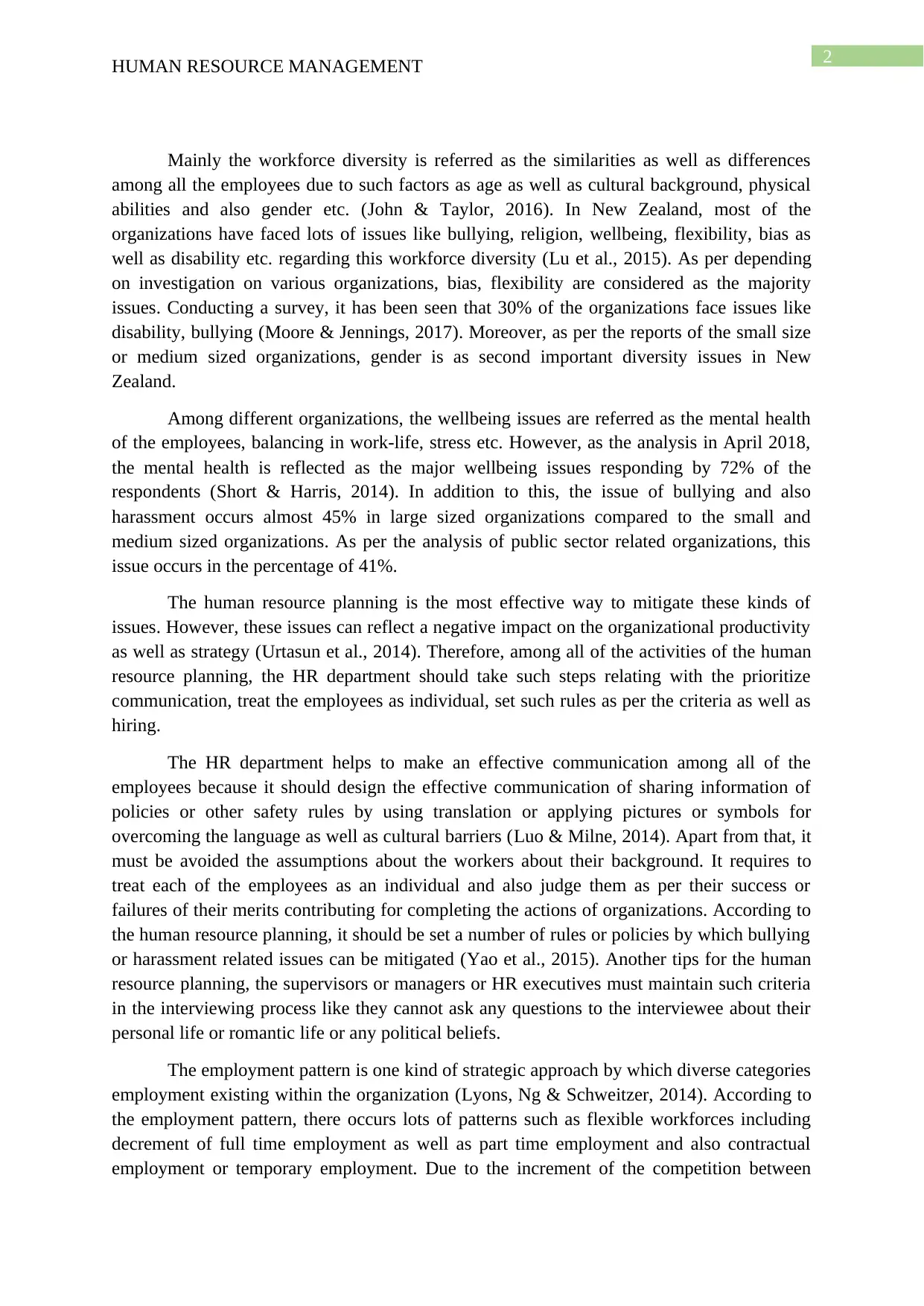
2
HUMAN RESOURCE MANAGEMENT
Mainly the workforce diversity is referred as the similarities as well as differences
among all the employees due to such factors as age as well as cultural background, physical
abilities and also gender etc. (John & Taylor, 2016). In New Zealand, most of the
organizations have faced lots of issues like bullying, religion, wellbeing, flexibility, bias as
well as disability etc. regarding this workforce diversity (Lu et al., 2015). As per depending
on investigation on various organizations, bias, flexibility are considered as the majority
issues. Conducting a survey, it has been seen that 30% of the organizations face issues like
disability, bullying (Moore & Jennings, 2017). Moreover, as per the reports of the small size
or medium sized organizations, gender is as second important diversity issues in New
Zealand.
Among different organizations, the wellbeing issues are referred as the mental health
of the employees, balancing in work-life, stress etc. However, as the analysis in April 2018,
the mental health is reflected as the major wellbeing issues responding by 72% of the
respondents (Short & Harris, 2014). In addition to this, the issue of bullying and also
harassment occurs almost 45% in large sized organizations compared to the small and
medium sized organizations. As per the analysis of public sector related organizations, this
issue occurs in the percentage of 41%.
The human resource planning is the most effective way to mitigate these kinds of
issues. However, these issues can reflect a negative impact on the organizational productivity
as well as strategy (Urtasun et al., 2014). Therefore, among all of the activities of the human
resource planning, the HR department should take such steps relating with the prioritize
communication, treat the employees as individual, set such rules as per the criteria as well as
hiring.
The HR department helps to make an effective communication among all of the
employees because it should design the effective communication of sharing information of
policies or other safety rules by using translation or applying pictures or symbols for
overcoming the language as well as cultural barriers (Luo & Milne, 2014). Apart from that, it
must be avoided the assumptions about the workers about their background. It requires to
treat each of the employees as an individual and also judge them as per their success or
failures of their merits contributing for completing the actions of organizations. According to
the human resource planning, it should be set a number of rules or policies by which bullying
or harassment related issues can be mitigated (Yao et al., 2015). Another tips for the human
resource planning, the supervisors or managers or HR executives must maintain such criteria
in the interviewing process like they cannot ask any questions to the interviewee about their
personal life or romantic life or any political beliefs.
The employment pattern is one kind of strategic approach by which diverse categories
employment existing within the organization (Lyons, Ng & Schweitzer, 2014). According to
the employment pattern, there occurs lots of patterns such as flexible workforces including
decrement of full time employment as well as part time employment and also contractual
employment or temporary employment. Due to the increment of the competition between
HUMAN RESOURCE MANAGEMENT
Mainly the workforce diversity is referred as the similarities as well as differences
among all the employees due to such factors as age as well as cultural background, physical
abilities and also gender etc. (John & Taylor, 2016). In New Zealand, most of the
organizations have faced lots of issues like bullying, religion, wellbeing, flexibility, bias as
well as disability etc. regarding this workforce diversity (Lu et al., 2015). As per depending
on investigation on various organizations, bias, flexibility are considered as the majority
issues. Conducting a survey, it has been seen that 30% of the organizations face issues like
disability, bullying (Moore & Jennings, 2017). Moreover, as per the reports of the small size
or medium sized organizations, gender is as second important diversity issues in New
Zealand.
Among different organizations, the wellbeing issues are referred as the mental health
of the employees, balancing in work-life, stress etc. However, as the analysis in April 2018,
the mental health is reflected as the major wellbeing issues responding by 72% of the
respondents (Short & Harris, 2014). In addition to this, the issue of bullying and also
harassment occurs almost 45% in large sized organizations compared to the small and
medium sized organizations. As per the analysis of public sector related organizations, this
issue occurs in the percentage of 41%.
The human resource planning is the most effective way to mitigate these kinds of
issues. However, these issues can reflect a negative impact on the organizational productivity
as well as strategy (Urtasun et al., 2014). Therefore, among all of the activities of the human
resource planning, the HR department should take such steps relating with the prioritize
communication, treat the employees as individual, set such rules as per the criteria as well as
hiring.
The HR department helps to make an effective communication among all of the
employees because it should design the effective communication of sharing information of
policies or other safety rules by using translation or applying pictures or symbols for
overcoming the language as well as cultural barriers (Luo & Milne, 2014). Apart from that, it
must be avoided the assumptions about the workers about their background. It requires to
treat each of the employees as an individual and also judge them as per their success or
failures of their merits contributing for completing the actions of organizations. According to
the human resource planning, it should be set a number of rules or policies by which bullying
or harassment related issues can be mitigated (Yao et al., 2015). Another tips for the human
resource planning, the supervisors or managers or HR executives must maintain such criteria
in the interviewing process like they cannot ask any questions to the interviewee about their
personal life or romantic life or any political beliefs.
The employment pattern is one kind of strategic approach by which diverse categories
employment existing within the organization (Lyons, Ng & Schweitzer, 2014). According to
the employment pattern, there occurs lots of patterns such as flexible workforces including
decrement of full time employment as well as part time employment and also contractual
employment or temporary employment. Due to the increment of the competition between
⊘ This is a preview!⊘
Do you want full access?
Subscribe today to unlock all pages.

Trusted by 1+ million students worldwide
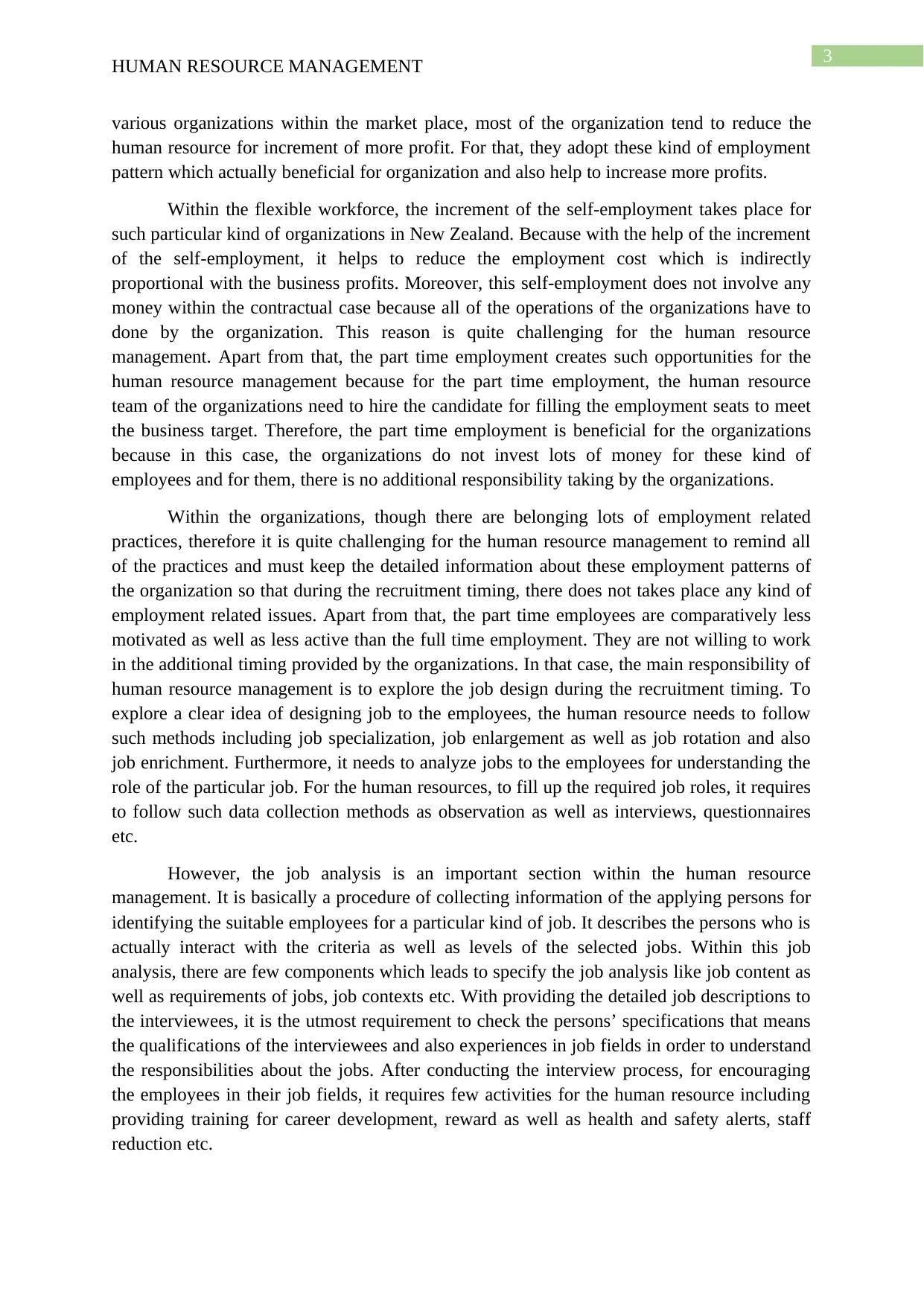
3
HUMAN RESOURCE MANAGEMENT
various organizations within the market place, most of the organization tend to reduce the
human resource for increment of more profit. For that, they adopt these kind of employment
pattern which actually beneficial for organization and also help to increase more profits.
Within the flexible workforce, the increment of the self-employment takes place for
such particular kind of organizations in New Zealand. Because with the help of the increment
of the self-employment, it helps to reduce the employment cost which is indirectly
proportional with the business profits. Moreover, this self-employment does not involve any
money within the contractual case because all of the operations of the organizations have to
done by the organization. This reason is quite challenging for the human resource
management. Apart from that, the part time employment creates such opportunities for the
human resource management because for the part time employment, the human resource
team of the organizations need to hire the candidate for filling the employment seats to meet
the business target. Therefore, the part time employment is beneficial for the organizations
because in this case, the organizations do not invest lots of money for these kind of
employees and for them, there is no additional responsibility taking by the organizations.
Within the organizations, though there are belonging lots of employment related
practices, therefore it is quite challenging for the human resource management to remind all
of the practices and must keep the detailed information about these employment patterns of
the organization so that during the recruitment timing, there does not takes place any kind of
employment related issues. Apart from that, the part time employees are comparatively less
motivated as well as less active than the full time employment. They are not willing to work
in the additional timing provided by the organizations. In that case, the main responsibility of
human resource management is to explore the job design during the recruitment timing. To
explore a clear idea of designing job to the employees, the human resource needs to follow
such methods including job specialization, job enlargement as well as job rotation and also
job enrichment. Furthermore, it needs to analyze jobs to the employees for understanding the
role of the particular job. For the human resources, to fill up the required job roles, it requires
to follow such data collection methods as observation as well as interviews, questionnaires
etc.
However, the job analysis is an important section within the human resource
management. It is basically a procedure of collecting information of the applying persons for
identifying the suitable employees for a particular kind of job. It describes the persons who is
actually interact with the criteria as well as levels of the selected jobs. Within this job
analysis, there are few components which leads to specify the job analysis like job content as
well as requirements of jobs, job contexts etc. With providing the detailed job descriptions to
the interviewees, it is the utmost requirement to check the persons’ specifications that means
the qualifications of the interviewees and also experiences in job fields in order to understand
the responsibilities about the jobs. After conducting the interview process, for encouraging
the employees in their job fields, it requires few activities for the human resource including
providing training for career development, reward as well as health and safety alerts, staff
reduction etc.
HUMAN RESOURCE MANAGEMENT
various organizations within the market place, most of the organization tend to reduce the
human resource for increment of more profit. For that, they adopt these kind of employment
pattern which actually beneficial for organization and also help to increase more profits.
Within the flexible workforce, the increment of the self-employment takes place for
such particular kind of organizations in New Zealand. Because with the help of the increment
of the self-employment, it helps to reduce the employment cost which is indirectly
proportional with the business profits. Moreover, this self-employment does not involve any
money within the contractual case because all of the operations of the organizations have to
done by the organization. This reason is quite challenging for the human resource
management. Apart from that, the part time employment creates such opportunities for the
human resource management because for the part time employment, the human resource
team of the organizations need to hire the candidate for filling the employment seats to meet
the business target. Therefore, the part time employment is beneficial for the organizations
because in this case, the organizations do not invest lots of money for these kind of
employees and for them, there is no additional responsibility taking by the organizations.
Within the organizations, though there are belonging lots of employment related
practices, therefore it is quite challenging for the human resource management to remind all
of the practices and must keep the detailed information about these employment patterns of
the organization so that during the recruitment timing, there does not takes place any kind of
employment related issues. Apart from that, the part time employees are comparatively less
motivated as well as less active than the full time employment. They are not willing to work
in the additional timing provided by the organizations. In that case, the main responsibility of
human resource management is to explore the job design during the recruitment timing. To
explore a clear idea of designing job to the employees, the human resource needs to follow
such methods including job specialization, job enlargement as well as job rotation and also
job enrichment. Furthermore, it needs to analyze jobs to the employees for understanding the
role of the particular job. For the human resources, to fill up the required job roles, it requires
to follow such data collection methods as observation as well as interviews, questionnaires
etc.
However, the job analysis is an important section within the human resource
management. It is basically a procedure of collecting information of the applying persons for
identifying the suitable employees for a particular kind of job. It describes the persons who is
actually interact with the criteria as well as levels of the selected jobs. Within this job
analysis, there are few components which leads to specify the job analysis like job content as
well as requirements of jobs, job contexts etc. With providing the detailed job descriptions to
the interviewees, it is the utmost requirement to check the persons’ specifications that means
the qualifications of the interviewees and also experiences in job fields in order to understand
the responsibilities about the jobs. After conducting the interview process, for encouraging
the employees in their job fields, it requires few activities for the human resource including
providing training for career development, reward as well as health and safety alerts, staff
reduction etc.
Paraphrase This Document
Need a fresh take? Get an instant paraphrase of this document with our AI Paraphraser
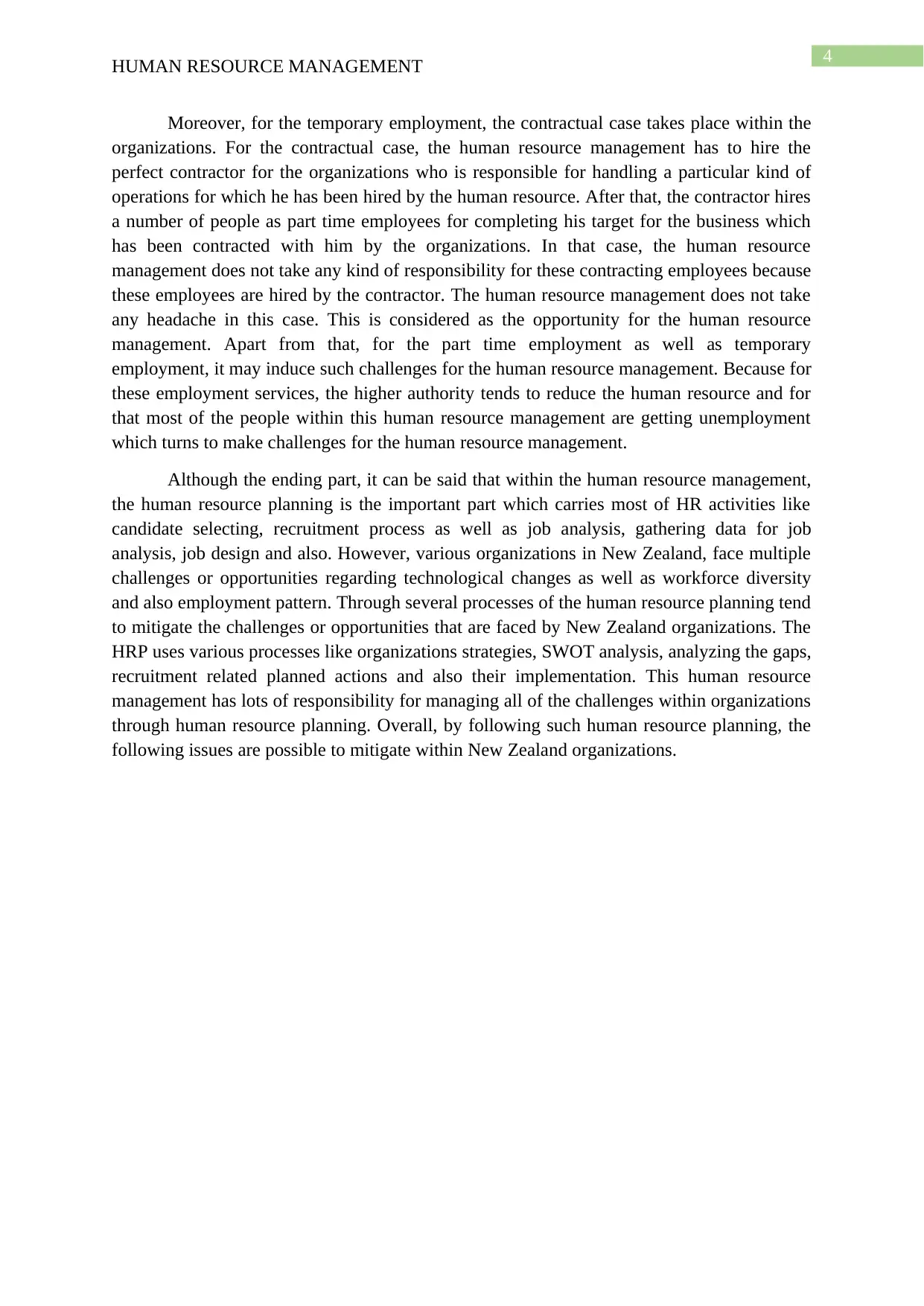
4
HUMAN RESOURCE MANAGEMENT
Moreover, for the temporary employment, the contractual case takes place within the
organizations. For the contractual case, the human resource management has to hire the
perfect contractor for the organizations who is responsible for handling a particular kind of
operations for which he has been hired by the human resource. After that, the contractor hires
a number of people as part time employees for completing his target for the business which
has been contracted with him by the organizations. In that case, the human resource
management does not take any kind of responsibility for these contracting employees because
these employees are hired by the contractor. The human resource management does not take
any headache in this case. This is considered as the opportunity for the human resource
management. Apart from that, for the part time employment as well as temporary
employment, it may induce such challenges for the human resource management. Because for
these employment services, the higher authority tends to reduce the human resource and for
that most of the people within this human resource management are getting unemployment
which turns to make challenges for the human resource management.
Although the ending part, it can be said that within the human resource management,
the human resource planning is the important part which carries most of HR activities like
candidate selecting, recruitment process as well as job analysis, gathering data for job
analysis, job design and also. However, various organizations in New Zealand, face multiple
challenges or opportunities regarding technological changes as well as workforce diversity
and also employment pattern. Through several processes of the human resource planning tend
to mitigate the challenges or opportunities that are faced by New Zealand organizations. The
HRP uses various processes like organizations strategies, SWOT analysis, analyzing the gaps,
recruitment related planned actions and also their implementation. This human resource
management has lots of responsibility for managing all of the challenges within organizations
through human resource planning. Overall, by following such human resource planning, the
following issues are possible to mitigate within New Zealand organizations.
HUMAN RESOURCE MANAGEMENT
Moreover, for the temporary employment, the contractual case takes place within the
organizations. For the contractual case, the human resource management has to hire the
perfect contractor for the organizations who is responsible for handling a particular kind of
operations for which he has been hired by the human resource. After that, the contractor hires
a number of people as part time employees for completing his target for the business which
has been contracted with him by the organizations. In that case, the human resource
management does not take any kind of responsibility for these contracting employees because
these employees are hired by the contractor. The human resource management does not take
any headache in this case. This is considered as the opportunity for the human resource
management. Apart from that, for the part time employment as well as temporary
employment, it may induce such challenges for the human resource management. Because for
these employment services, the higher authority tends to reduce the human resource and for
that most of the people within this human resource management are getting unemployment
which turns to make challenges for the human resource management.
Although the ending part, it can be said that within the human resource management,
the human resource planning is the important part which carries most of HR activities like
candidate selecting, recruitment process as well as job analysis, gathering data for job
analysis, job design and also. However, various organizations in New Zealand, face multiple
challenges or opportunities regarding technological changes as well as workforce diversity
and also employment pattern. Through several processes of the human resource planning tend
to mitigate the challenges or opportunities that are faced by New Zealand organizations. The
HRP uses various processes like organizations strategies, SWOT analysis, analyzing the gaps,
recruitment related planned actions and also their implementation. This human resource
management has lots of responsibility for managing all of the challenges within organizations
through human resource planning. Overall, by following such human resource planning, the
following issues are possible to mitigate within New Zealand organizations.
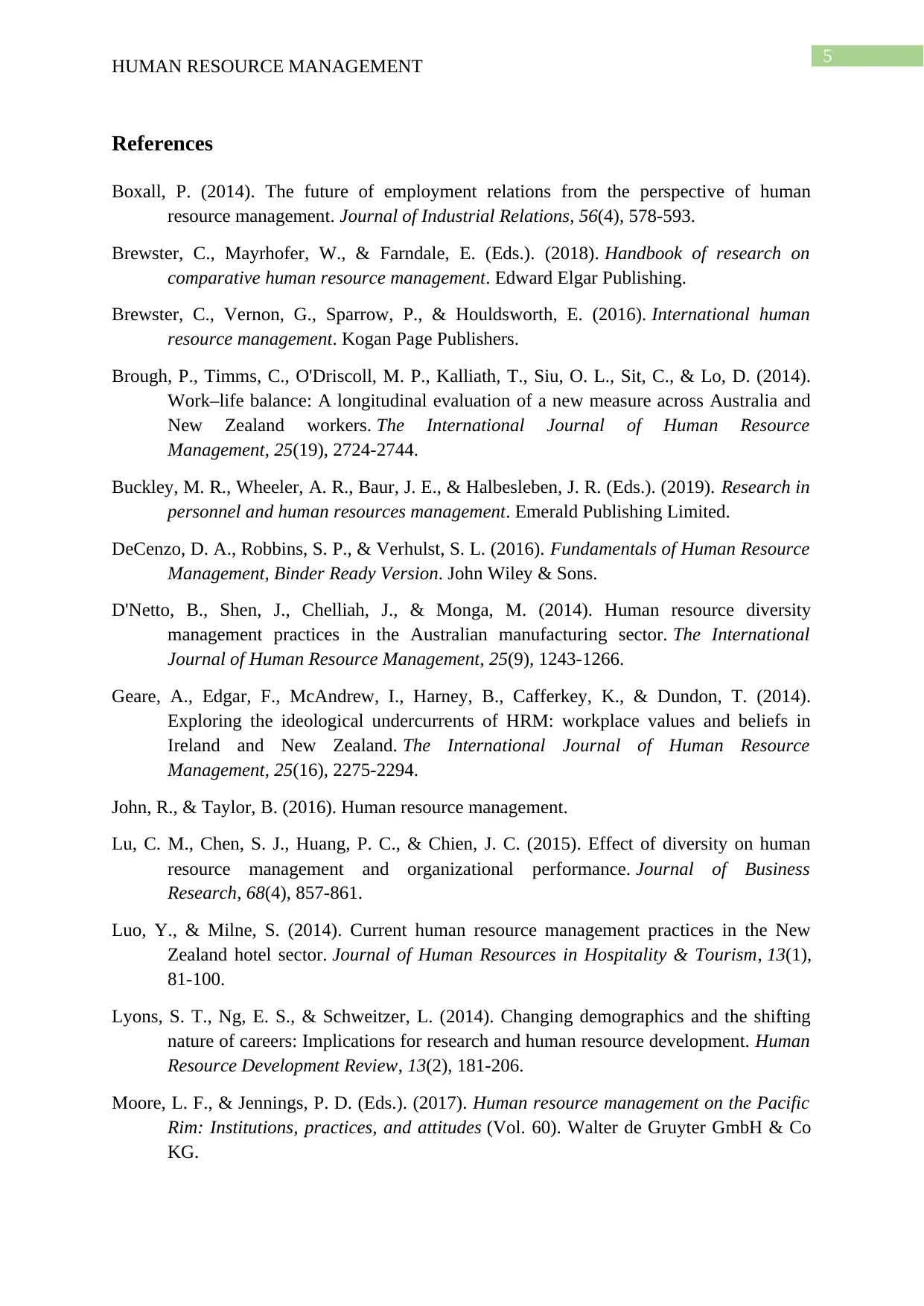
5
HUMAN RESOURCE MANAGEMENT
References
Boxall, P. (2014). The future of employment relations from the perspective of human
resource management. Journal of Industrial Relations, 56(4), 578-593.
Brewster, C., Mayrhofer, W., & Farndale, E. (Eds.). (2018). Handbook of research on
comparative human resource management. Edward Elgar Publishing.
Brewster, C., Vernon, G., Sparrow, P., & Houldsworth, E. (2016). International human
resource management. Kogan Page Publishers.
Brough, P., Timms, C., O'Driscoll, M. P., Kalliath, T., Siu, O. L., Sit, C., & Lo, D. (2014).
Work–life balance: A longitudinal evaluation of a new measure across Australia and
New Zealand workers. The International Journal of Human Resource
Management, 25(19), 2724-2744.
Buckley, M. R., Wheeler, A. R., Baur, J. E., & Halbesleben, J. R. (Eds.). (2019). Research in
personnel and human resources management. Emerald Publishing Limited.
DeCenzo, D. A., Robbins, S. P., & Verhulst, S. L. (2016). Fundamentals of Human Resource
Management, Binder Ready Version. John Wiley & Sons.
D'Netto, B., Shen, J., Chelliah, J., & Monga, M. (2014). Human resource diversity
management practices in the Australian manufacturing sector. The International
Journal of Human Resource Management, 25(9), 1243-1266.
Geare, A., Edgar, F., McAndrew, I., Harney, B., Cafferkey, K., & Dundon, T. (2014).
Exploring the ideological undercurrents of HRM: workplace values and beliefs in
Ireland and New Zealand. The International Journal of Human Resource
Management, 25(16), 2275-2294.
John, R., & Taylor, B. (2016). Human resource management.
Lu, C. M., Chen, S. J., Huang, P. C., & Chien, J. C. (2015). Effect of diversity on human
resource management and organizational performance. Journal of Business
Research, 68(4), 857-861.
Luo, Y., & Milne, S. (2014). Current human resource management practices in the New
Zealand hotel sector. Journal of Human Resources in Hospitality & Tourism, 13(1),
81-100.
Lyons, S. T., Ng, E. S., & Schweitzer, L. (2014). Changing demographics and the shifting
nature of careers: Implications for research and human resource development. Human
Resource Development Review, 13(2), 181-206.
Moore, L. F., & Jennings, P. D. (Eds.). (2017). Human resource management on the Pacific
Rim: Institutions, practices, and attitudes (Vol. 60). Walter de Gruyter GmbH & Co
KG.
HUMAN RESOURCE MANAGEMENT
References
Boxall, P. (2014). The future of employment relations from the perspective of human
resource management. Journal of Industrial Relations, 56(4), 578-593.
Brewster, C., Mayrhofer, W., & Farndale, E. (Eds.). (2018). Handbook of research on
comparative human resource management. Edward Elgar Publishing.
Brewster, C., Vernon, G., Sparrow, P., & Houldsworth, E. (2016). International human
resource management. Kogan Page Publishers.
Brough, P., Timms, C., O'Driscoll, M. P., Kalliath, T., Siu, O. L., Sit, C., & Lo, D. (2014).
Work–life balance: A longitudinal evaluation of a new measure across Australia and
New Zealand workers. The International Journal of Human Resource
Management, 25(19), 2724-2744.
Buckley, M. R., Wheeler, A. R., Baur, J. E., & Halbesleben, J. R. (Eds.). (2019). Research in
personnel and human resources management. Emerald Publishing Limited.
DeCenzo, D. A., Robbins, S. P., & Verhulst, S. L. (2016). Fundamentals of Human Resource
Management, Binder Ready Version. John Wiley & Sons.
D'Netto, B., Shen, J., Chelliah, J., & Monga, M. (2014). Human resource diversity
management practices in the Australian manufacturing sector. The International
Journal of Human Resource Management, 25(9), 1243-1266.
Geare, A., Edgar, F., McAndrew, I., Harney, B., Cafferkey, K., & Dundon, T. (2014).
Exploring the ideological undercurrents of HRM: workplace values and beliefs in
Ireland and New Zealand. The International Journal of Human Resource
Management, 25(16), 2275-2294.
John, R., & Taylor, B. (2016). Human resource management.
Lu, C. M., Chen, S. J., Huang, P. C., & Chien, J. C. (2015). Effect of diversity on human
resource management and organizational performance. Journal of Business
Research, 68(4), 857-861.
Luo, Y., & Milne, S. (2014). Current human resource management practices in the New
Zealand hotel sector. Journal of Human Resources in Hospitality & Tourism, 13(1),
81-100.
Lyons, S. T., Ng, E. S., & Schweitzer, L. (2014). Changing demographics and the shifting
nature of careers: Implications for research and human resource development. Human
Resource Development Review, 13(2), 181-206.
Moore, L. F., & Jennings, P. D. (Eds.). (2017). Human resource management on the Pacific
Rim: Institutions, practices, and attitudes (Vol. 60). Walter de Gruyter GmbH & Co
KG.
⊘ This is a preview!⊘
Do you want full access?
Subscribe today to unlock all pages.

Trusted by 1+ million students worldwide
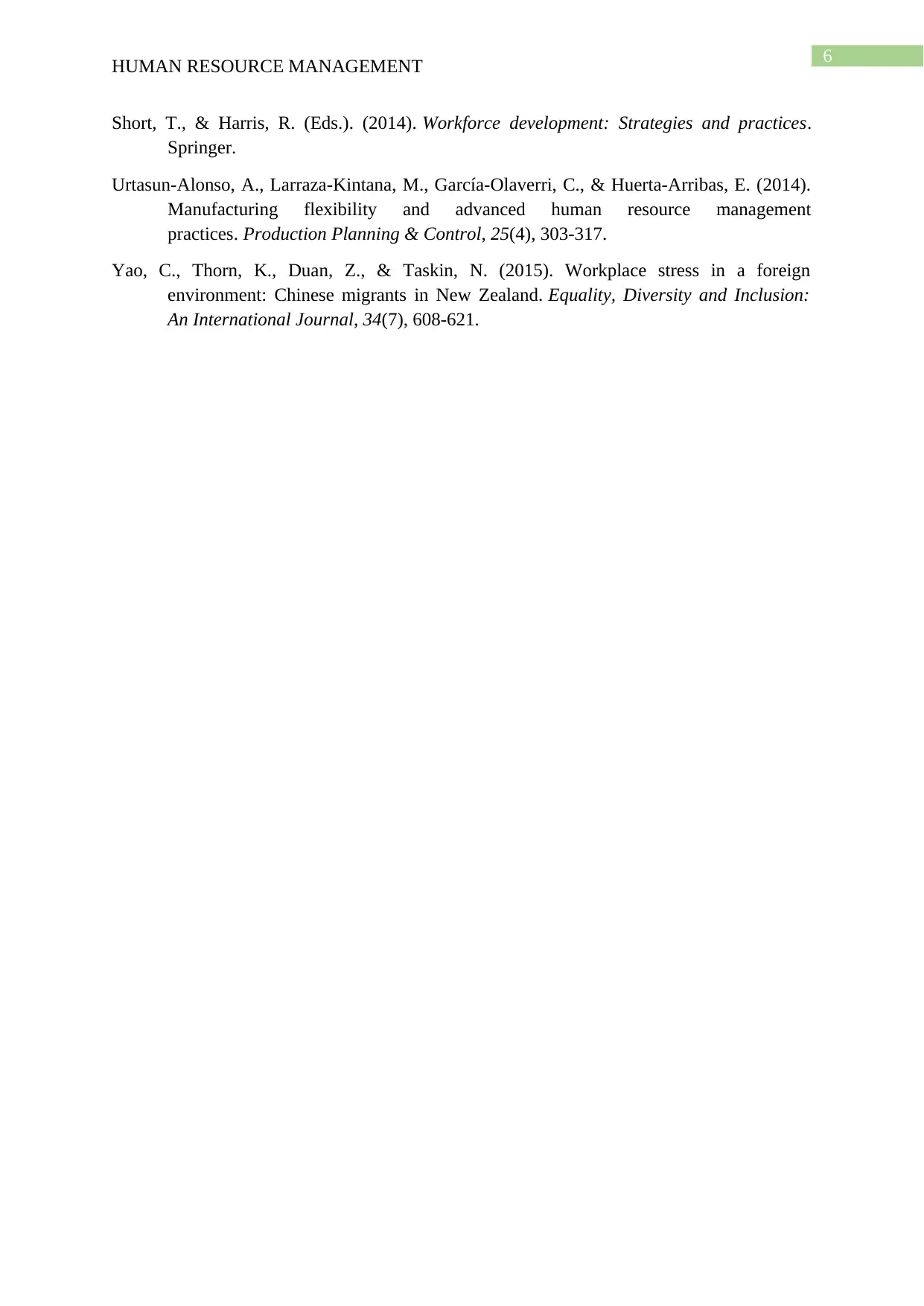
6
HUMAN RESOURCE MANAGEMENT
Short, T., & Harris, R. (Eds.). (2014). Workforce development: Strategies and practices.
Springer.
Urtasun-Alonso, A., Larraza-Kintana, M., García-Olaverri, C., & Huerta-Arribas, E. (2014).
Manufacturing flexibility and advanced human resource management
practices. Production Planning & Control, 25(4), 303-317.
Yao, C., Thorn, K., Duan, Z., & Taskin, N. (2015). Workplace stress in a foreign
environment: Chinese migrants in New Zealand. Equality, Diversity and Inclusion:
An International Journal, 34(7), 608-621.
HUMAN RESOURCE MANAGEMENT
Short, T., & Harris, R. (Eds.). (2014). Workforce development: Strategies and practices.
Springer.
Urtasun-Alonso, A., Larraza-Kintana, M., García-Olaverri, C., & Huerta-Arribas, E. (2014).
Manufacturing flexibility and advanced human resource management
practices. Production Planning & Control, 25(4), 303-317.
Yao, C., Thorn, K., Duan, Z., & Taskin, N. (2015). Workplace stress in a foreign
environment: Chinese migrants in New Zealand. Equality, Diversity and Inclusion:
An International Journal, 34(7), 608-621.
1 out of 7
Related Documents
Your All-in-One AI-Powered Toolkit for Academic Success.
+13062052269
info@desklib.com
Available 24*7 on WhatsApp / Email
![[object Object]](/_next/static/media/star-bottom.7253800d.svg)
Unlock your academic potential
Copyright © 2020–2025 A2Z Services. All Rights Reserved. Developed and managed by ZUCOL.




